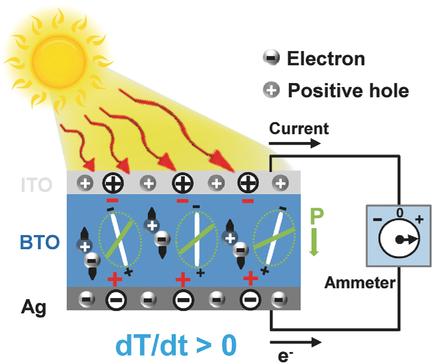当前位置:
X-MOL 学术
›
Adv. Mater.
›
论文详情
Our official English website, www.x-mol.net, welcomes your feedback! (Note: you will need to create a separate account there.)
Photovoltaic–Pyroelectric Coupled Effect Induced Electricity for Self‐Powered Photodetector System
Advanced Materials ( IF 29.4 ) Pub Date : 2017-10-23 , DOI: 10.1002/adma.201703694 Nan Ma 1, 2 , Kewei Zhang 1, 2 , Ya Yang 1, 2
Advanced Materials ( IF 29.4 ) Pub Date : 2017-10-23 , DOI: 10.1002/adma.201703694 Nan Ma 1, 2 , Kewei Zhang 1, 2 , Ya Yang 1, 2
Affiliation

|
Ferroelectric materials have demonstrated novel photovoltaic effect to scavenge solar energy. However, most of the ferroelectric materials with wide bandgaps (2.7–4 eV) suffer from low power conversion efficiency of less than 0.5% due to absorbing only 8–20% of solar spectrum. Instead of harvesting solar energy, these ferroelectric materials can be well suited for photodetector applications, especially for sensing near‐UV irradiations. Here, a ferroelectric BaTiO3 film‐based photodetector is demonstrated that can be operated without using any external power source and a fast sensing of 405 nm light illumination is enabled. As compared with photovoltaic effect, both the responsivity and the specific detectivity of the photodetector can be dramatically enhanced by larger than 260% due to the light‐induced photovoltaic–pyroelectric coupled effect. A self‐powered photodetector array system can be utilized to achieve spatially resolved light intensity detection by recording the output voltage signals as a mapping figure.
中文翻译:

自供电光电探测器系统的光伏-热电耦合效应感应电
铁电材料已展示出新颖的光伏效应来清除太阳能。但是,大多数具有宽禁带宽度(2.7–4 eV)的铁电材料由于仅吸收8–20%的太阳光谱而遭受不到0.5%的低功率转换效率。这些铁电材料无需收集太阳能,而是非常适合光电探测器应用,尤其是用于感测近紫外线辐射。在这里,铁电BaTiO 3演示了基于胶片的光电探测器,无需使用任何外部电源即可运行,并且可以快速检测405 nm光照。与光电效应相比,由于光诱导的光电热电耦合效应,光电探测器的响应率和比探测率都可以显着提高260%以上。通过将输出电压信号记录为映射图,可以利用自供电的光电探测器阵列系统来实现空间分辨的光强度检测。
更新日期:2017-10-23
中文翻译:

自供电光电探测器系统的光伏-热电耦合效应感应电
铁电材料已展示出新颖的光伏效应来清除太阳能。但是,大多数具有宽禁带宽度(2.7–4 eV)的铁电材料由于仅吸收8–20%的太阳光谱而遭受不到0.5%的低功率转换效率。这些铁电材料无需收集太阳能,而是非常适合光电探测器应用,尤其是用于感测近紫外线辐射。在这里,铁电BaTiO 3演示了基于胶片的光电探测器,无需使用任何外部电源即可运行,并且可以快速检测405 nm光照。与光电效应相比,由于光诱导的光电热电耦合效应,光电探测器的响应率和比探测率都可以显着提高260%以上。通过将输出电压信号记录为映射图,可以利用自供电的光电探测器阵列系统来实现空间分辨的光强度检测。



























 京公网安备 11010802027423号
京公网安备 11010802027423号